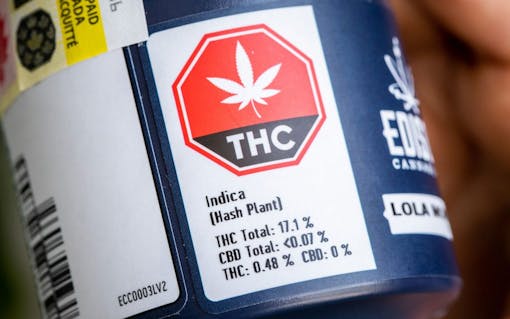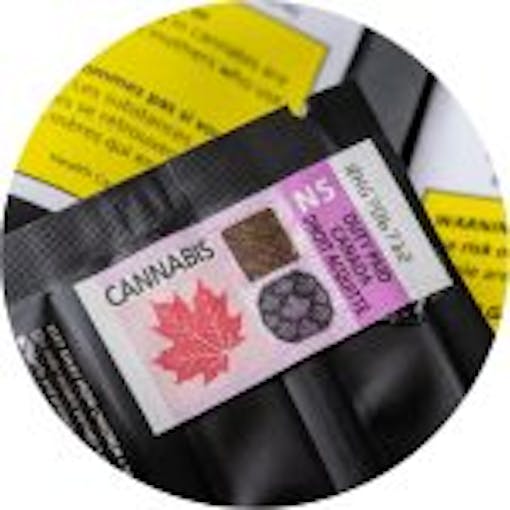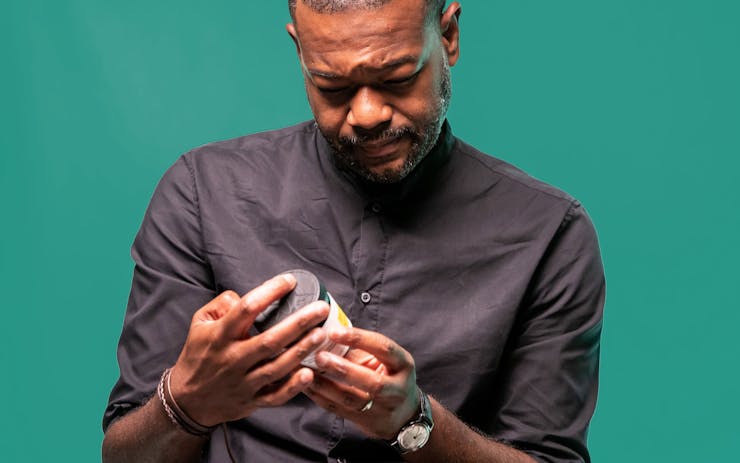Whether you’re a new consumer or a connoisseur, Canadian cannabis labels can be a bit hard to unpack. When you buy flower, or even a single preroll, you receive a package that is dense with details.
Brands can make limited changes to the size, materials, and colours of their packaging, but for the most part, they are bound by strict labelling regulations.
So, let’s dive into it all—what do those labels and text mean? Here’s how to make sense of the details included on Canadian cannabis packages:Join the Leafly Canada Community
Product Specifics and Potency
Brand Name and Logo
Although Health Canada’s promotional restrictions are very tight, this is one area licensed producers can communicate brand information to consumers.
Strain Name

In the new legal system, strain names are chosen by the producer to differentiate between varietals, and are often designed to give insight into a strain’s potential effects.
Cannabinoid Content
Licensed producers are required to list information about the plant’s two major cannabinoids, THC (tetrahydrocannabinol, the compound that can cause a high) and CBD (cannabidiol, a non-intoxicating cannabinoid).
Q. How is potency calculated?
A. Producers can only communicate the potential potency of flower and prerolls—it’s the theoretical maximum amount of THC (or CBD) present in your product after all the cannabinoids are activated through the process called decarbolyxation, aka lighting up. This process takes a “precursor” cannabinoid like THCA and converts it into THC. This value will appear on packaging as “total THC”, and should be calculated as follows:
Total Potential THC = (0.877 * %THCA) + %THC
It accounts for the weight difference between THCA and THC, and assumes 100% conversion of THCA into THC. But the conversion efficiency may not be 100%, which is why this is a maximum estimate. The real amount of THC available for consumption will probably be lower.
Confusingly, packages containing whole flower express maximum cannabinoid potential as a percentage while packages containing prerolls communicate cannabinoid potential differently, focusing on the total milligrams (mg) of THC and CBD per joint.
The result of this distinction in labelling details is that the same varietal from the same brand will have slightly different THC and CBD expressions, depending on whether it’s being sold whole or pre-rolled.
For instance, if you purchase a single gram container of Lola Montes flower from Edison Cannabis Co., cannabinoid ratios will be expressed like this:

The label for this batch of Lola Montes from Edison reads: THC Total: 17.1% CBD Total: <0.07%; THC: 0.48% CBD: 0%
However, if you purchase a preroll of Lola Montes, it will look like this:

The label for this Lola Montes preroll from Edison reads: THC (per unit): 1.60 mg CBD (per unit): 0 mg; Total THC per unit: 72.5 mg Total CBD per unit: <0.35 mg
For a more direct comparison, convert the mg per unit into a percentage by following Edison’s formula (for 0.5 g joints specifically):
(mg per unit) * 2 = Y
Y / 1000 = Z
Z * 100 = Percentage of unit
In this specific case, there’s 72.5 mg of THC in 0.5 g, so 145 mg in a single gram ( 72.5 * 2 = 145). Divide 145 by 1000 to put it in grams = 0.145 ( 145 / 1000 = 0.145 ). Multiply 0.145 by 100 and you get a percentage of 14.5 (0.145 * 100 = 14.5%). Now we know that the preroll (14.5% THC) is less potent than the dried flower (17.1% THC). Consumers should expect cannabinoid content to vary from one batch to the next.
Note that for products that have already been decarboxylated, such as capsules, oils, and edibles, producers list total cannabinoid content in milligrams.
Lot Number
Found on most products sold in Canada, lot numbers are assigned to a quantity or lot of material from a single producer/manufacturer.
If a recall of a product is issued, this is the number you would check.
Cannabis Class
Cannabis class refers to the type of product contained within the package (seeds, dried flower, oil, capsule, etc.).
Weight
This is the amount of cannabis contained in the package, measured in grams or milliliters, depending on the product class. Health Canada allows for weight fluctuations of +/- 10%
Warnings

Photo by Jesse Milns/Leafly
Warning Labels
Printed on a standardized yellow-and-black background, warning labels must contain at least one of Health Canada’s pre-written warnings.
One secondary warning that must be printed on all cannabis packaging is “KEEP OUT OF REACH OF CHILDREN”, in French and English.
Standardized Cannabis Symbol

The standard 1.27 cm x 1.27 cm symbol is required by Health Canada on all cannabis products containing more than a negligible amount of THC. To simplify that, this symbol means that there is THC in the product.
Procedural
Producer Information
The name of the company who produced the cannabis product.
Contact Information
As per regulation, a phone number and email address of the producer must be displayed.
Excise Stamp

For consumers, the presence of this excise stamp is a surefire way to know that your cannabis isn’t counterfeit.
Barcode

Dates
Cannabis product packaging must have the date it was packaged on the label. Some producers list an expiry date, but most do not.
Directions
Recommended Storage Conditions
Cannabis packages in Canada provide basic information on how to keep cannabis fresh but for more information, including dos and don’ts, check out Leafly’s guide to storing cannabis.
Opening Instructions

These black and white instructions detail how to open the childproof packaging.
With files from Nick Jikomes.





